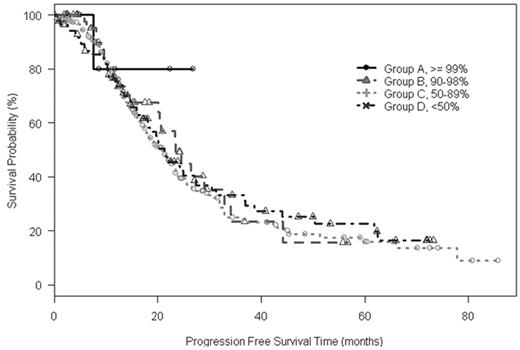Abstract
One potential approach to improve the results of autologous stem cell transplantation (ASCT) in multiple myeloma (MM) involves the use of more potent induction regimens; the achievement of deeper remission pre-ASCT should translate into longer progression-free (PFS) and overall survival (OS). To evaluate this hypothesis, we assessed the influence of the percent reduction in serum monoclonal protein (M protein) pre-ASCT in patients (pts) treated with dexamethasone-based regimens (most often VAD) on the best response, PFS and OS achieved after ASCT. Between 2000–2006, 376 pts with IgG (267) or IgA (109) non-progressive MM underwent ASCT. Median age was 59 (21–73) yrs; 60% were male. The median hemoglobin at diagnosis was 103 g/L, creatinine 98 μmol/L, β2-microglobulin 241 nmol/L and albumin 35 g/L. Maintenance therapy was given to 84 (22%) after ASCT and consisted of corticosteroids in 29, thalidomide in 10, both in 41 and other regimens in 4 pts. Patients were divided into 4 groups based on the per cent reduction in M protein after induction therapy:
group A, ≥ 99%;
group B, 90–98%;
group C, 50–89%;
group D, < 50%.
Post-ASCT responses included complete remission (CR), very good partial remission (VGPR) (≥ 90% reduction in M protein), PR (≥ 50% reduction) and stable disease (SD). Median follow-up from diagnosis is 37.4 mos and from ASCT 24.1 mos. For all pts, the median OS from diagnosis is 90.8 mos (95% CI 73.9–129.1 mos) and from ASCT 63.9 mos (95% CI 50.8–69.4 mos), while the median PFS from ASCT is 21.3 mos (95% CI 19.1–23.3 mos). Maintenance therapy had no significant effect on PFS (p=0.49) or OS (p=0.59). The post-ASCT results in evaluable patients according to the percent reduction in M protein after induction therapy are summarized below. We conclude:
High-grade remissions after dexamethasone-based induction therapy are uncommon, with only 2% achieving ≥ 99% and 13% achieving 90–98% reduction in serum M protein;
post-ASCT CR and VGPR rates were higher in these 2 groups;
there was no significant difference in PFS or OS-based on protein response prior to transplant;
whether newer induction regimens, which incorporate novel agents and which produce more CRs and VGPRs before ASCT, will confer better PFS and OS post-ASCT will be of great interest.
| Group . | N . | CR (%)1 . | VGPR (%)1 . | PR (%)1 . | SD (%)1 . | Median PFS (mo)2 . | Median OS (mo)3 . |
|---|---|---|---|---|---|---|---|
| 1p<0.001;2p=0.77;3p=0.79 | |||||||
| A | 7 | 50 | 50 | Not reached | Not reached | ||
| B | 47 | 19 | 64 | 17 | 23.3 | Not reached | |
| C | 232 | 14 | 17 | 68 | 1 | 20.7 | 59.1 |
| D | 87 | 11 | 7 | 54 | 28 | 21.1 | 69.4 |
| Group . | N . | CR (%)1 . | VGPR (%)1 . | PR (%)1 . | SD (%)1 . | Median PFS (mo)2 . | Median OS (mo)3 . |
|---|---|---|---|---|---|---|---|
| 1p<0.001;2p=0.77;3p=0.79 | |||||||
| A | 7 | 50 | 50 | Not reached | Not reached | ||
| B | 47 | 19 | 64 | 17 | 23.3 | Not reached | |
| C | 232 | 14 | 17 | 68 | 1 | 20.7 | 59.1 |
| D | 87 | 11 | 7 | 54 | 28 | 21.1 | 69.4 |
Figure
Figure
Author notes
Disclosure: No relevant conflicts of interest to declare.



